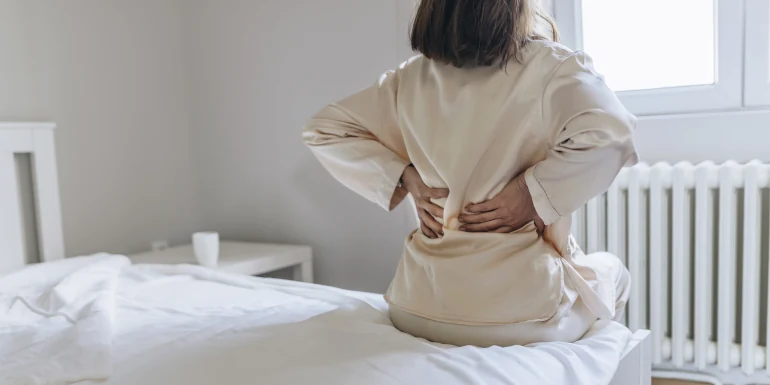
Herniated disc – what should you do?
Herniated discs can be very painful. Learn what you can do about them, which therapy helps and why an operation is rarely necessary.
A herniated disc is a spinal condition where parts of the intervertebral disc protrude into the spinal canal and can press on a nerve there. Herniated discs are common triggers for back pain. However, pain that spreads – into the arms or legs, depending on the case – is usually the primary concern.
Typical symptoms of a herniated disc (slipped disc)
- Sudden onset of severe back pain
- Pain spreads to the buttocks, legs, feet or from the neck to the arms
- Tight muscles in the area of the spine
- Numbness or tingling sensations
- In extreme cases: paralysis in the legs or arms
Which symptoms occur, and if at all, depends on how severely the nerve structures are affected. Herniated discs are usually unproblematic: they often go unnoticed, some cause severe pain, and in rare cases they can be dangerous if they cause nerve damage. Medical professionals refer to this as a slipped disc or a prolapsed disc.
Severe pain in the lower back that occurs with no other symptoms may be lumbar spine syndrome, also known as acute lumbago – or more commonly “lower back pain”. Usually harmless, lumbar spine syndrome causes the muscles in the back to tense.
When should you see a doctor?
A herniated disc often makes itself apparent several days before it occurs. Make sure you get to the bottom of what’s causing your back pain:
- If it persists for longer than four weeks
- As soon as the pain spreads to other parts of the body
- Sensory disturbances or paralysis occur
Unsure if your complaints warrant a visit to the doctor? The medical specialists at Medi24 are available around the clock:
Hotline: 0800 100 008 (free from a Swiss landline/mobile rates charged by provider)
Herniated discs explained
The intervertebral discs are located between the 24 movable vertebrae of our spine. They keep it agile and help to absorb shock. The pressure on the intervertebral discs is enormous: even when we’re just standing, our lumbar spine can bear more than our own body weight; when sitting, it can bear twice that weight. When we bend over, it even withstands several hundred kilograms. It’s therefore a good idea to strengthen your core muscles, as they stabilise your spine and help protect it from strain.
On the outside, the intervertebral disc consists of a fibrous ring; on the inside, it consists of a gel-like tissue, the gelatinous core. If the outer layer ruptures, this tissue leaks out and presses against the nerve roots or the spinal cord. Triggers for this are genetic predisposition, smoking, years of strain, age-related tissue degradation and, in rare cases, an accident. You often hear people talking of pinched discs, but it is in fact the other way around – it’s the disc that pinches the nerves.
A herniated disc usually occurs in the lower lumbar spine, and sometimes in the cervical spine. The thoracic spine is very rarely affected.
Causes of a slipped disc
The elasticity of the intervertebral discs decreases as a person gets older. Genetic predisposition and years of wear and tear can also lead to intervertebral disc damage. A slipped disc is therefore the final stage in a long process. Sometimes all it takes is a trigger to bring the problem to light, such as a sudden movement or twist – and the pain hits you like a ton of bricks.
Risks for herniated discs
- Long periods of sitting or standing
- Lack of exercise
- Weak core muscles
- Poor posture and strain
- Lifting heavy objects
- Head constantly tilted forward (text neck)
- Being overweight
Preventing a herniated disc
Your spine loves movement, so make a habit out of the following:
- Avoid sitting or standing for too long.
- For sedentary work, a standing desk, stool or stability ball can help.
- Rock back and forth occasionally while standing.
- Incorporate plenty of dynamic activities into your lifestyle such as walking, running, swimming and dancing.
- Strengthen your spine with abdominal and back strength training.
- Stretch your back frequently in all directions.
- Balance and coordination exercises can also help.
How to train your back
In the Helsana Coach app, you’ll find numerous exercises for maintaining a strong and healthy back. Helsana Coach shows you how you can strengthen, loosen up and mobilise your muscles.
Treatment and therapy
In most cases, herniated discs can be treated without an operation. If the pain is tolerable and you aren’t experiencing any muscle weakness or paralysis, physiotherapy and pain medication are the first options. The aim of physiotherapy is to correct bad posture and to strengthen the pelvic and back muscles. If necessary, anti-inflammatory pain medication may help. A course of therapy lasts six to eight weeks on average.
If the situation doesn’t improve, interventional pain management comes into question. This involves specifically treating the nerve roots causing the pain by means of injections (infiltration). If it is unclear what is causing the pain, the injections can also help to locate and treat the pain.
An operation is usually the last resort if nothing else works or if there is a risk of permanent damage, such as paralysis in the legs or arms, due to excess pressure on the nerves. The nerves responsible for bladder and bowel movements are very rarely affected. In such a case, an emergency operation must be performed; the surgeon will usually use a minimally invasive procedure, i.e. using a small microscope or camera (endoscope), to remove the bulging disc tissue.

Dr Guy Waisbrod is a senior consultant for spinal surgery and orthopaedics at the Swiss Paraplegic Centre, Nottwil. He also heads the project of an interdisciplinary back centre. Dr Waisbrod gave our editorial team advice and input for this article.


Newsletter
Find out more about current health issues every month and get all the information you need about our attractive offers from all Helsana Group companies * delivered by e-mail to read whenever it suits you. Our newsletter is free of charge and you can sign up here:
We did not receive your information. Please try again later.
* The Helsana Group comprises Helsana Insurance Company Ltd, Helsana Supplementary Insurances Ltd and Helsana Accidents Ltd.
